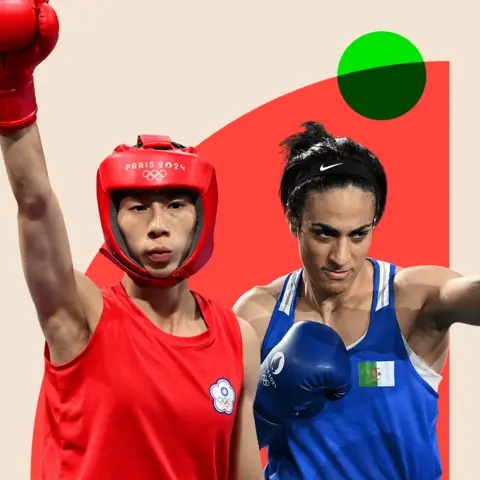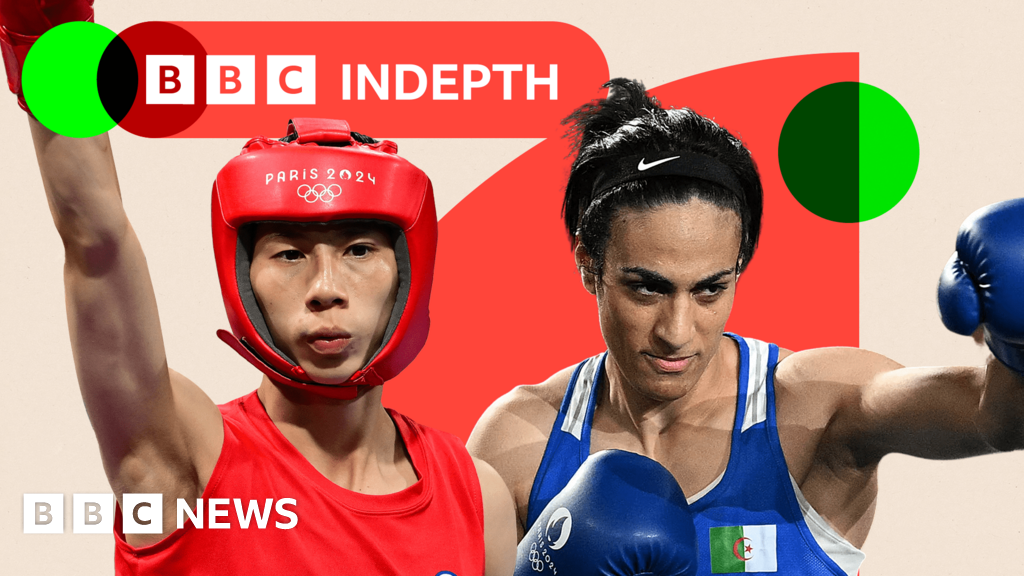What does science tell us about boxing’s gender row?
 BBC
BBCImages of the Algerian boxer Imane Khelif and Taiwan’s Lin Yu-ting on the medal podium in Paris will go down as some of the most unforgettable of the 2024 Olympics.
A frenzied debate has raged over the International Olympic Committee clearing the duo to compete in the women’s boxing in Paris, despite them having been disqualified from last year’s Women’s World Championships for failing to meet eligibility criteria.
Amid the heat, science is shedding increasing light on our different chromosomal make-ups and what advantages they may bring to sport.
But the research is ongoing and even among the experts who spend their professional lives working on it, there are differing interpretations on what the science tells us.
We do know that the process of sex determination starts when a foetus is developing. Most females get two X chromosomes (XX), while most males get an X and a Y chromosome (XY).
Chromosomes influence a person’s sex. But hormones are important too, before birth – as well as later on during puberty. While the baby is still growing in the womb, hormones help the reproductive organs develop.
However, at some point through the pregnancy some babies’ reproductive organs don’t develop in the way most people’s do.
This can be caused by conditions called DSDs: differences in sex development.
There are a group of about 40 conditions involving genes, hormones and reproductive organs that develop in the womb. It means a person’s sex development is different from that of most other people’s.
These chromosome abnormalities are rare – but they have come into sharp focus because of the boxing row at the Olympics.
So what do we know about the two boxers at the heart of the gender row?
Both fighters were said to have failed International Boxing Association gender eligibility tests last year – but there has been conflicting information whether XY chromosomes or elevated testosterone were found.
While representatives of the fighters and the IOC insist the fighters were “born women, raised as women and always competed as women”, critics, including some of their opponents at Paris 2024, have speculated that perhaps the fighters have DSD.
Because these genetic variations are so many and so varied, some experts say it’s impossible to establish that everyone with a Y chromosome is a male and everyone without a Y chromosome is a female.
“Just looking at the presence of a Y chromosome on its own does not answer the question of whether someone is male or female,” says Prof Alun Williams, who researches genetic factors related to sport performance at the Manchester Metropolitan University Institute of Sport.
“It’s obviously a very good marker, as most people with a Y chromosome are male…but it’s not a perfect indicator.”
For some people with DSD, the Y chromosome is not a fully formed typical male Y chromosome. It may have some genetic material missing, damaged or swapped with the X chromosome, depending on the variation.
When it comes to being male or female, what is usually crucial is a specific gene called SRY – which stands for ‘sex-determining region of the Y chromosome’.
“This is what is called the make-male gene. It’s the master switch of sex development,” says Dr Emma Hilton, a developmental biologist who studies genetic disorders. She is also a trustee of the Sex Matters charity, which argues Imane Khelif and Lin Yu-ting shouldn’t be competing until further testing is done.
There are some people born with XY chromosomes who have lost what Dr Hilton calls the “make-male” gene.
“These people don’t make testosterone. They develop a very typical female anatomy,” Dr Hilton says.
So a test that identifies XY chromosomes does not offer a complete picture. And in the case of Imane Khelif and Lin Yu-ting, the IBA has not disclosed details of the way they were tested.
However, Dr Hilton also says that in most people with XY chromosomes, the SRY “make-male” gene is present.
These people usually have testicles which are often inside the body.
“When they hit puberty they start producing testosterone – which is what underpins male advantage in sports,” says Dr Hilton.
The most famous example is Caster Semenya – a double Olympic gold medallist and three-time world champion over 800m, though Prof Alun Williams says there is not direct evidence that DSD athletes have the same advantage as typical males.
The roadblock is in a gene required to generate external genitalia – which boys need in order to grow a penis. Anyone with the same condition as Caster Semenya has a mutation within that gene that stops it functioning normally.
In the womb, they will develop a male anatomy until the final stage of growing a penis – and when they are not able to, then they’ll start developing a vulva and a clitoris.
But they don’t develop female reproductive organs: they don’t have a cervix or a uterus.
These people don’t have periods and they can’t get pregnant. Having sex with males can be difficult.
Discovering you have this kind of genetic mutation can be a shock.
“The most recent woman we diagnosed with having XY chromosomes was 33,” says Claus Højbjerg Gravholt – an endocrinology professor at Aarhus University who spent the past 30 years dealing with DSD.
His patient came to see him because she had no idea why she couldn’t get pregnant.
“We discovered she didn’t have a uterus, so she would never be able to have a baby. She was absolutely devastated.”
Prof Gravholt says the implications that come with questioning one’s gender identity can be destabilising – and he often refers his patients to a psychologist.
“If I showed you her photo, you would say: that’s a woman. She has a female body, she is married to a man. She feels like a female. And that is the case for most of my patients.”
When Prof Gravholt asked her why she didn’t consult a doctor about not getting periods, she said there was another older woman in her family who never menstruated – so she thought it wasn’t abnormal.
There is another genetic mutation Prof Gravholt has come across.
He has diagnosed males who have XX chromosomes – which are normally found in females. “These men are infertile. They look like normal males, but their testes are smaller than average and don’t produce sperm. It’s always devastating when they find out. As they grow older, they stop producing testosterone in the way most men do.”
In some cultures, talking openly about periods and female anatomy is not culturally acceptable. In some parts of the world, women may lack the education to understand that there’s something atypical going on in their bodies.
And that’s why experts believe that many DSDs are never diagnosed – which means that comprehensive data is scarce.
But Prof Gravholt points to figures from Denmark as a good indicator.
“Denmark is probably the best country in the world at collecting this data – we have a national registry with everyone who has ever had a chromosome examination.”
He says that XY chromosomes in females are very rare – in Denmark it’s about one in 15,000.
But he believes that when adding these many genetic conditions together, about one in 300 people are affected.
“We are learning that these variations are more common than we thought,” Prof Gravholt says. “A lot of patients are being diagnosed later in life. The oldest person I diagnosed was a male in his 60s.”
Will the gender controversy change things at the Olympics?
Do people with differences of sex development have an unfair advantage in sport? The short answer is that there is not enough data to reach a definitive conclusion.
“It wouldn’t surprise me if some people with a type of DSD had some physical advantage over women,” says Prof Alun Williams. Those advantages could include larger muscle mass, as well as bigger and longer bones and larger organs such as lungs and heart.
He says they may also have higher levels of blood haemoglobin that lead to improved oxygen delivery to where it’s needed in working muscles.
“Some people with some types of DSDs might have advantages in some or all of those elements, ranging from 0-100%, depending on the type of DSD and its precise genetic cause.”
He believes his opinion is representative of the experts in his field, but that more evidence is needed.
When it comes to Imane Khelif and Lin Yu-ting, we don’t have enough information to know if they have a DSD that would need to be regulated.
Regulating elite sports, which typically rely on male-female binary categories in competition, is complicated because the biology of sex itself is complex.
Dr Shane Heffernan has a PhD in molecular genetics in elite sports and is currently working on a paper on what athletes think about competitors with a DSD.
He says it’s all about the nuance of the individual’s genetic condition.
For example, females with a DSD known as androgen insensitivity syndrome have XY chromosomes; they produce testosterone; but their bodies aren’t equipped to process it. So they don’t get any of the benefits from that testosterone, like males do.
Dr Heffernan says that there aren’t enough known and studied athletes with a DSD to make a valid scientific conclusion as to whether they definitely have an advantage, and as to whether they should be eligible or ineligible to compete in the female category.
He believes that the International Olympic Committee is not basing its eligibility criteria on the best available science.
“This is worrying. The IOC makes an ‘assumption of no advantage’ – but there is no direct evidence for this, nor that there is a performance advantage with DSD athletes solely because of their genetic variations.
“We simply don’t have enough data. Many people hold an emotional position when it comes to inclusion in the female category, but how can the IOC justify this position – without the data to support it?”
He is one of many people who are urging the Olympics committee, international federations and funding councils to invest in research on athletes with a DSD – but he appreciates it’s difficult, because there can be a lot of stigma towards the individual athletes when it comes to these conditions.
Some are calling for mandatory sex testing at the next Olympics – including Reem Alsalem, the UN’s special rapporteur on violence against women and girls.
“Screening DNA is now a piece of cake,” Dr Emma Hilton says. “A simple cheek swab would be sufficient, and it’s minimally invasive.”
She says swabs should happen when athletes first register for their first affiliated competition – before they start winning medals and the spotlight hits them, so as to avoid what happened with Imane Khelif.
But there’s disagreement on that among scientists.
“A cheek swab wouldn’t allow you to reach a robust conclusion on someone’s sex and potential advantage in sport,” says Prof Williams.
He argues a comprehensive sex test would have to include these three categories:
1. Genetics (including looking for a Y chromosome and the SRY “make-male” gene).
2. Hormones (including, but not limited to, testosterone).
3. The body’s responsiveness to hormones like testosterone. Some people might have a Y chromosome, but be completely insensitive to testosterone.
He believes this is currently not being done because it’s expensive, it requires people with very specific expertise – and there are ethical concerns about the testing procedure.
“This assessment can be humiliating. It includes measurements of the most intimate parts of anatomy, like the size of your breast and your clitoris, the depth of your voice, the extent of your body hair.”
One thing is certain: this controversy is not going away.
For now, science is not yet able to offer a definitive view on how people with differing chromosomal make-ups should be categorised for the purposes of elite sport. For those who spend their lives trying to make sense of the science, their hope is that this latest row will propel much-needed research.
BBC InDepth is the new home on the website and app for the best analysis and expertise from our top journalists. Under a distinctive new brand, we’ll bring you fresh perspectives that challenge assumptions, and deep reporting on the biggest issues to help you make sense of a complex world. And we’ll be showcasing thought-provoking content from across BBC Sounds and iPlayer too. We’re starting small but thinking big, and we want to know what you think – you can send us your feedback by clicking on the button below.









